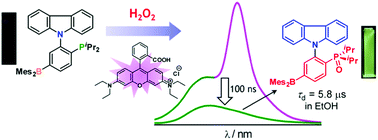Rational design of time-resolved turn-on fluorescence sensors: exploiting delayed fluorescence for hydrogen peroxide sensing†
Abstract
Weakly emissive phosphine compounds, which contain a carbazolyl donor−triarylboryl acceptor luminophore, become strongly delayed fluorescent upon changes to their oxide forms. Time-gated acquisition of the fluorescence signals of phosphine in the presence of H2O2 and a competitive fluorescence dye allow for detection of H2O2 with elimination of short-lived fluorescence noise.



 Please wait while we load your content...
Please wait while we load your content...